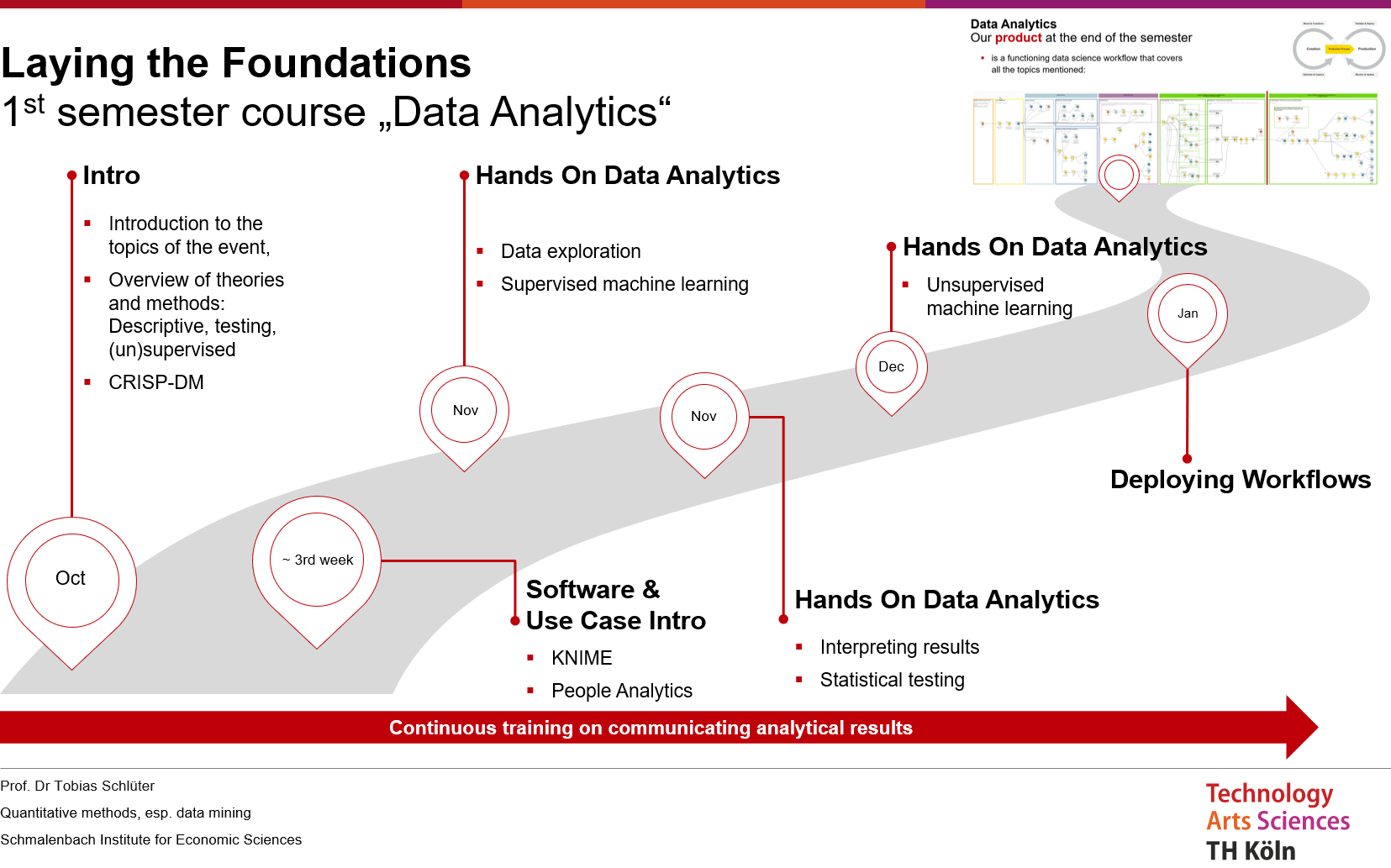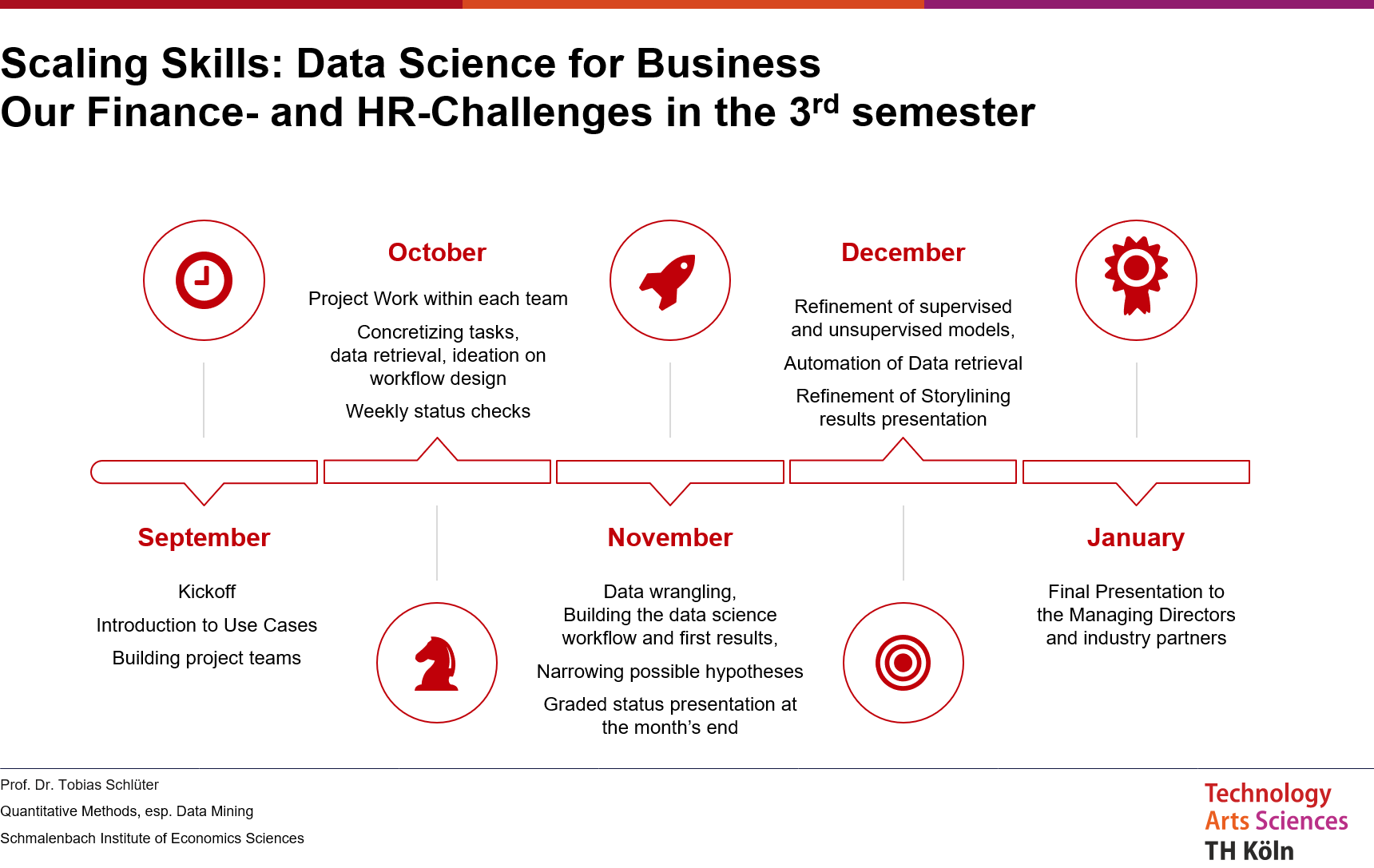At universities of applied sciences, our teaching focus is coupled with a highly practical business orientation. I’d like to outline how, in my role as professor, this influences how I teach data science to master students in business administration.
Tobias Schlüter is Professor at TH Köln in the Faculty of Business, Economics and Law. His teaching disciplines include data science for business, and applied analytics in banking while his research concentrates on analytics an data science for business and pricing for financial institutions.
My students will work in a quickly developing business world after graduation. More data will be available, while decisions will have to be made ever faster. In topics like marketing, HR, and product management, there is rarely a single correct course of action. Hence my goal is to teach how to best evaluate different approaches. I’m guided by these questions:
-
How can I prepare my students to make good, meaningful, data-based decisions in their future positions, instead of just going with their guts?
-
How can I enable them to become effective managers in their respective domains — ones who both understand the possibilities of more available data and modern data analytics and can also apply it?
My Teaching Objectives and why I chose KNIME
In the area of tension between specializations in business and data science, three aspects were important for me. The first mainly impacts the structure and design of my lectures, while the other two have led me to adopt KNIME for my lectures.
The Do It Yourself Approach and Real Challenges
Students have to learn data science practically. Instead of me flipping through PowerPoint slides, they have to work with data and design algorithmic workflows. They should also preferably learn about challenges in a business context, with real data sets, project structures, deadlines, and ideally with managers from the field.
Get Productive Fast
Students need easy access to tools. Whether they have previous experience with creating analyses or not, with KNIME, I only need about 90 minutes to introduce the basic concepts of the platform and enable them to create their first predictive models or apply a variety of analytics methods. From there they can choose from the available materials to continue their learning.
Using an Industry-Relevant Tool
Students should be exposed to software that is used by actual companies, to support their transition to working in the industry. In the case of KNIME, they use exactly the same software (with no artificial limitations) that many companies already use, and which all can use.
The Data Science Journey in the Master Program
Laying the Foundations
To provide students with the skills to discern which technique is best to solve the problem at hand, we lay a solid foundation for assessing and evaluating challenges in the first semester course “Data Analytics.” The initial weeks are regular front-of-class teaching. What opportunities and potentials does Big Data offer? What classes of algorithms are there? What distinguishes descriptive statistics from modern machine learning algorithms? How does the CRISP-DM work? And so on.
Applying Lessons to Business Problems
Students are then given a seemingly simple problem: The board of directors at your company is concerned about employees quitting. Can you help the board assess which employees are at risk of quitting? Every student immediately has a sense of why they would quit a job. Over the rest of the term, we work with these perceptions to find insights from HR data, and leverage the benefits modern data analytics can offer.

Generating and Communicating Data-driven Insights to Business Executives
With KNIME, our students move from simple data exploration, descriptive statistics, and interactive visualizations to unsupervised machine learning and a range of supervised ML models. Furthermore, they learn to implement data science workflows, avoid analytical pitfalls, and validate theories with statistical tests, as well as how to communicate their approaches, model choices, and results in the most easily understandable and convincing way possible, even in conversation. Clear arguments count more than formulas and algorithms when talking to executives.
Scaling Skills: Advanced Data Science Challenges with Industry Partners
A crucial goal of my teaching is to scale my students’ analytical skills in real-world projects. In project-based followup courses with industry partners, students learn to deal with real use cases, work with messy datasets, and decide which approaches work best with various problems. Let's take a look at our data science challenges at TH Köln.
Several industry partners provide use cases, questions, and real data from their everyday work with Risk Management in Banking, Pricing for Insurance Companies, Marketing, Social Media Analytics, or Web Analytics. The students are free to choose which use case best suits their specialization. Leveraging their prior KNIME knowledge, they can meet a wide variety of new challenges:
-
Big Data datasets with millions of customer records and hundreds of features — How can they create efficient and robust predictive models?
-
Very noisy data — How can data pre-processing be optimized to meet the pricing models of insurance companies?
-
Web scraping or APIs for social media data — How can they quickly collect meaningful data sets themselves using KNIME web scraping or Python integrations in their KNIME workflows?
-
Analysis of Unstructured Data — How can they connect KNIME directly to a source like Twitter and use TextMining algorithms?

I coordinate several projects throughout the course. Before the course starts, I organize use cases and find practitioners interested in a university collaboration. After introducing the cases in the first session, I run weekly status checks with every team to ensure targets will be accomplished on time, while sparring on data science workflows or presenting results to case partners.
The Immediate Clarity of the Approach Accelerates Understanding Between a Data Scientist and a Business Executive
What is particularly interesting is that none of our industry partners have used KNIME to work on the provided use cases. Still, a scenario like this often arises during our regular meetings: Students will present their KNIME workflow, and a partner will at first reply with "I don't know KNIME.” But soon they’ll say, "I understood the workflow." This is a major advantage of visual programming compared to coding-based languages. Good collaboration happens much faster — not only among students, but even with those who haven't seen the software before; they can start using it immediately.
The Supportive Data Science Community
How do the students manage new methods and analytical skills, class requirements, and time pressures? They are supported throughout the semester by the KNIME Educators Alliance team. (Thank you for your support!) The team has contributed everything from a guest lecture introducing previously unknown topics (such as social media analytics) to lending aid when the students don’t know what to do next. A custom tag for our challenges in the KNIME Forum has also been extremely helpful. Our students can quickly get assistance from the KNIME community. To all KNIMErs throughout the world, thank you very much for supporting Cologne’s students!
To further incentivize students to create outstanding solutions, the winning teams are awarded prizes sponsored by KNIME. They include digital badges, which help signal to potential employers that they are already trained in data science. Such opportunities to present their work to the KNIME community also help students to shape their professional profiles before graduation.
A Data Analytics Tool for Any Use Case
With my experience in running and leading data science projects in a business context, I may conclude that by the end of their studies, students go through a data science project setting exactly as they would in the business world. With KNIME, they have a tool they can implement in any use case quickly and effectively. They can take these skills directly with them to the companies they go on to work for.
What my students say about using KNIME:
Emma Wissmann, currently working on web analytics:
I first used KNIME for data analysis as part of my first semester course at the TH Köln, and have been working with it intensively ever since. What I like about KNIME is that the software is easy to use due to the visual programming language and the user-friendly interface.
Markus Bünnemeyer, currently working with text mining:
I love the no-coding approach, but also appreciate the ability to code myself if needed. This mixture makes KNIME very pleasant for beginners, and at the same time very powerful for professionals.
